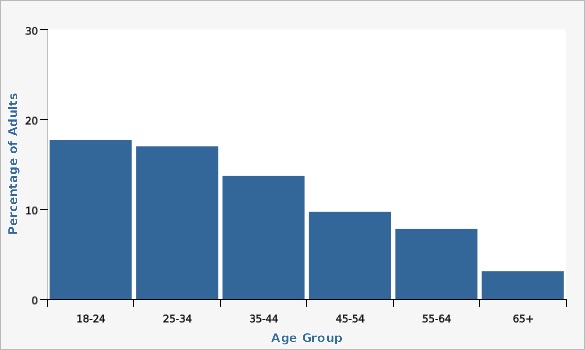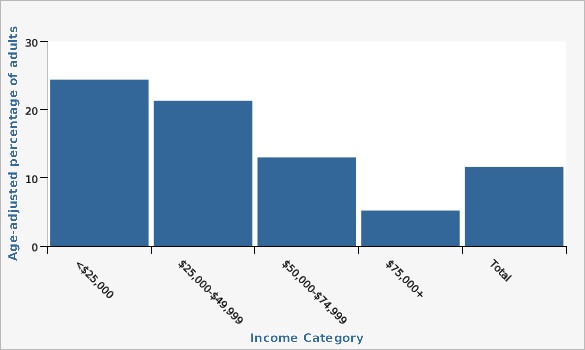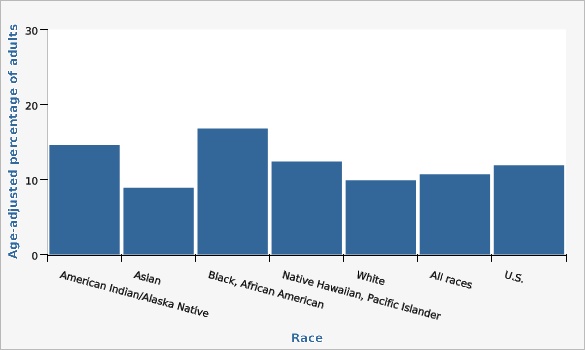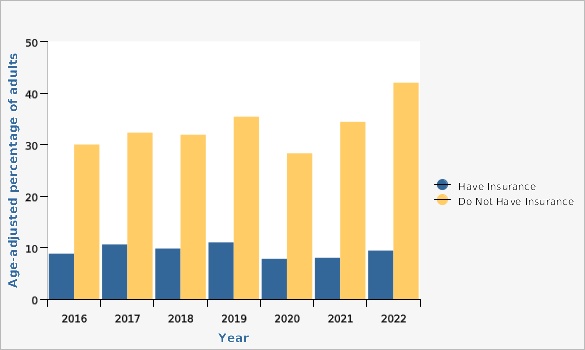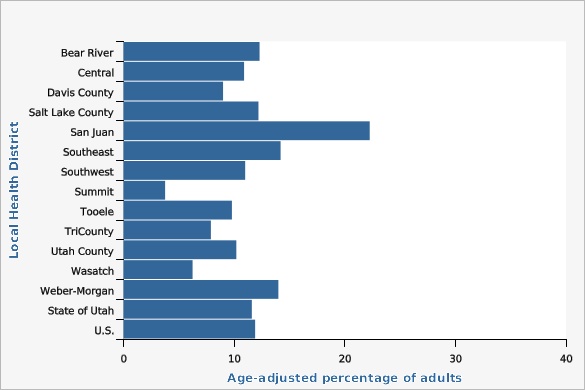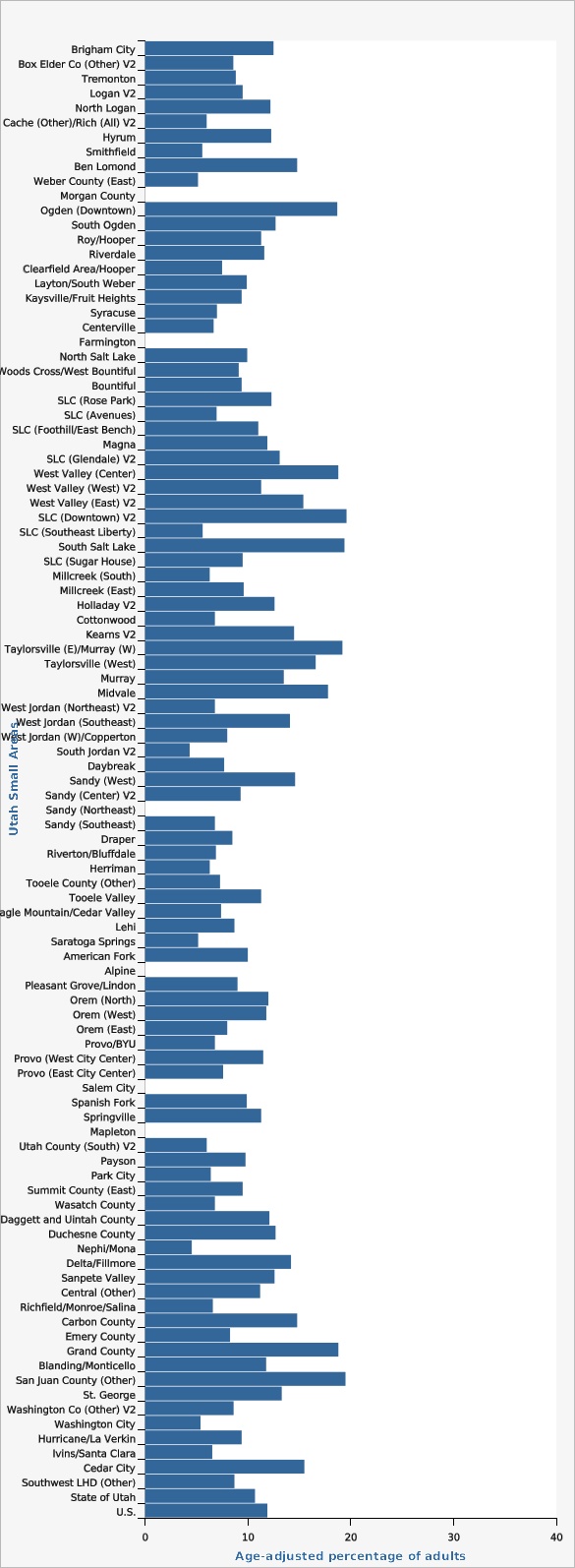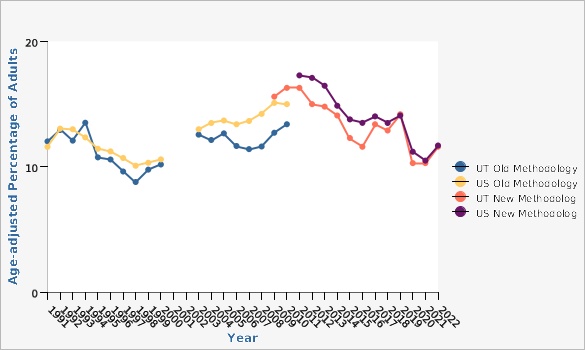Complete Health Indicator Report of Cost as a Barrier to Health Care
Definition
Percentage of adults aged 18 years and older who reported they were unable to receive needed health care in the past year due to cost.Numerator
Number of survey respondents who reported they were unable to receive needed health care in the past year due to cost.Denominator
Total number of survey respondents excluding those with missing, "Don't know/Not sure", and "Refused" answers.Data Interpretation Issues
Question Text: "Was there a time in the past 12 months when you needed to see a doctor but could not because of cost?" Starting in 2009, the BRFSS included both landline and cell phone respondent interviews along with a new weighting methodology called iterative proportional fitting, or raking. This methodology utilizes additional demographic information (such as education, race, and marital status) in the weighting procedure. Both of these methodology changes were implemented to account for an increased number of U.S. households without landline phones and an under-representation of certain demographic groups that were not well-represented in the sample. More details about these changes can be found at: [https://ibis.health.utah.gov/pdf/opha/resource/brfss/RakingImpact2011.pdf]. As with all surveys, some error results from nonresponse (e.g., refusal to participate in the survey or to answer specific questions), and measurement (e.g., social desirability or recall bias). Error was minimized by use of strict calling protocols, good questionnaire design, standardization of interviewer behavior, interviewer training, and frequent, on-site interviewer monitoring and supervision.Why Is This Important?
Access to health care is still a problem for many Utahns. Individuals who cannot obtain needed health care tend to have higher rates of death and disability from chronic disease. Cost is the most commonly reported barrier to getting needed health care.Other Objectives
Related to HP2030 Objective AHS-4: Reduce the proportion of people who can't get medical care when they need it [[br]]'''U.S. Target:''' 3.3%How Are We Doing?
The age-adjusted percentage of Utah adults who reported being unable to see a doctor in the past 12 months due to cost was 11.6% in 2022. The percentage (crude rate) was the highest for adults aged 18-24 (17.7%) and lowest for Utah adults aged 65 and older (3.1%). In 2022, Utah adults with low incomes had a higher age-adjusted rate (24.4%) of reporting cost as a barrier to health care than those with higher incomes (5.2%), as did those without health insurance (42.0%) versus the insured (9.4%).How Do We Compare With the U.S.?
When comparing Utah to the U.S. as a whole, the age-adjusted percentage of adults who reported they were unable to get needed health care in the past year due to cost has been similar over the years. In 2022, this percentage was 11.7% in the U.S. compared to 11.6% in Utah.What Is Being Done?
The Utah Department of Health and Human Services administers programs to improve access to care, such as Medicaid, the Children's Health Insurance Program (CHIP), UPP (Utah's Premium Partnership for Health Insurance), primary care grants, and clinics for children with disabilities. Local health departments provide preventive services such as immunizations and screenings at low or no cost to eligible persons who cannot afford them. Members of the Association for Utah Community Health (AUCH), including Federally Qualified Health Centers and other providers, strive to meet the needs of the medically underserved in Utah.Available Services
Utah Medicaid Program: [[br]] phone 1-800-662-9651, or visit [https://medicaid.utah.gov/] Utah Children's Health Insurance Program (CHIP): [[br]] phone 1-877-KIDS-NOW (1-877-543-7669) or visit [https://chip.health.utah.gov/] UPP (Utah's Premium Partnership for Health Insurance): [[br]] phone: 1-888-222-2542 (M - F, 8 a.m. -5 p.m.) [[br]] or visit [https://medicaid.utah.gov/upp/] The Association for Utah Community Health (AUCH) is the primary care association for the state of Utah. AUCH members include Federally Qualified Health Centers (FQHC) and other providers who strive to meet the needs of the medically underserved. AUCH and its member organizations are part of a statewide and national movement to reduce barriers to health care by enhancing primary care service delivery through prevention, health promotion, and community participation. Association for Utah Community Health [[br]] 860 East 4500 South [[br]] Salt Lake City, UT 84107 [[br]] Phone: (801) 974-5522 [[br]] [https://auch.org/]Related Indicators
Relevant Population Characteristics
Persons with low incomes have a higher percentage of problems with access to care than persons with higher incomes.Related Relevant Population Characteristics Indicators:
Health Care System Factors
Persons without health insurance have a higher percentage reporting cost as a barrier to care than those with health insurance coverage.Related Health Care System Factors Indicators:
Health Status Outcomes
Persons without access to health care tend to delay getting care until a problem becomes too painful or dangerous to avoid dealing with it. At this point, health problems are often expensive to treat and sometimes have serious long term implications for the individual's health. The health status of these persons may suffer due to lack of appropriate care.Related Health Status Outcomes Indicators:
Graphical Data Views
| Age Group | Percentage of Adults | Lower Limit | Upper Limit | |||
|---|---|---|---|---|---|---|
Record Count: 6 | ||||||
| 18-24 | 17.7% | 14.8% | 21.0% | |||
| 25-34 | 17.0% | 14.8% | 19.5% | |||
| 35-44 | 13.7% | 11.8% | 16.0% | |||
| 45-54 | 9.7% | 8.0% | 11.8% | |||
| 55-64 | 7.8% | 6.1% | 9.8% | |||
| 65+ | 3.1% | 2.2% | 4.3% | |||
Data Source
Utah Department of Health and Human Services Behavioral Risk Factor Surveillance System (BRFSS) [https://ibis.health.utah.gov/ibisph-view/query/selection/brfss/BRFSSSelection.html]| Income Category | Age-adjusted percentage of adults | Lower Limit | Upper Limit | |||
|---|---|---|---|---|---|---|
Record Count: 6 | ||||||
| <$25,000 | 24.4% | 20.3% | 29.2% | |||
| $25,000-$49,999 | 21.3% | 18.7% | 24.1% | |||
| $50,000-$74,999 | 13.0% | 10.7% | 15.7% | |||
| $75,000+ | 5.2% | 4.3% | 6.3% | |||
| Total | 11.6% | 10.7% | 12.4% | |||
Data Notes
Age-adjusted to the U.S. 2000 standard population.Data Source
Utah Department of Health and Human Services Behavioral Risk Factor Surveillance System (BRFSS) [https://ibis.health.utah.gov/ibisph-view/query/selection/brfss/BRFSSSelection.html]Adults age 25 and older reporting cost as a barrier to care in past year by education level, Utah, 2022
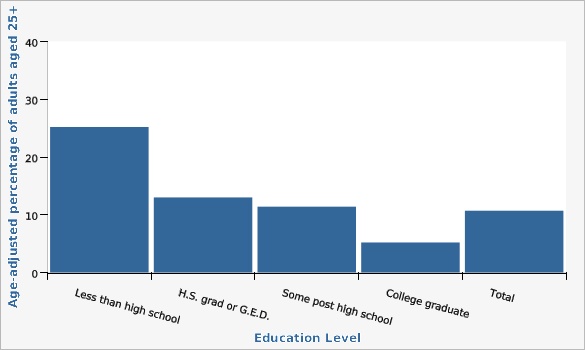
| Education Level | Age-adjusted percentage of adults aged 25+ | Lower Limit | Upper Limit | |||
|---|---|---|---|---|---|---|
Record Count: 5 | ||||||
| Less than high school | 25.2% | 20.4% | 30.6% | |||
| H.S. grad or G.E.D. | 13.0% | 11.2% | 15.1% | |||
| Some post high school | 11.4% | 9.9% | 13.2% | |||
| College graduate | 5.2% | 4.5% | 6.1% | |||
| Total | 10.7% | 9.8% | 11.6% | |||
Data Notes
Age-adjusted to U.S. 2000 standard population.Data Source
Utah Department of Health and Human Services Behavioral Risk Factor Surveillance System (BRFSS) [https://ibis.health.utah.gov/ibisph-view/query/selection/brfss/BRFSSSelection.html]| Hispanic Ethnicity | Age-adjusted percentage of adults | Lower Limit | Upper Limit | |||
|---|---|---|---|---|---|---|
Record Count: 4 | ||||||
| Hispanic/Latino | 22.6% | 19.5% | 25.9% | |||
| Non-Hispanic/Latino | 9.6% | 8.8% | 10.5% | |||
| All ethnicities | 11.6% | 10.7% | 12.4% | |||
| U.S. | 11.9% | 11.7% | 12.2% | |||
Data Notes
Age-adjusted to U.S. 2000 standard population.Data Sources
- Utah Department of Health and Human Services Behavioral Risk Factor Surveillance System (BRFSS) [https://ibis.health.utah.gov/ibisph-view/query/selection/brfss/BRFSSSelection.html]
- Behavioral Risk Factor Surveillance System Survey Data, US Department of Health and Human Services Centers for Disease Control and Prevention (CDC).
| Race | Age-adjusted percentage of adults | Lower Limit | Upper Limit | |||
|---|---|---|---|---|---|---|
Record Count: 7 | ||||||
| American Indian/Alaska Native | 14.6% | 11.1% | 19.0% | |||
| Asian | 8.9% | 6.3% | 12.5% | |||
| Black, African American | 16.8% | 12.5% | 22.2% | |||
| Native Hawaiian, Pacific Islander | 12.4% | 8.0% | 18.9% | |||
| White | 9.9% | 9.4% | 10.4% | |||
| All races | 10.7% | 10.3% | 11.2% | |||
| U.S. | 11.9% | 11.7% | 12.2% | |||
Data Notes
Age-adjusted to U.S. 2000 standard population based on 3 age groups: 18-34, 35-49, and 50+.Data Sources
- Utah Department of Health and Human Services Behavioral Risk Factor Surveillance System (BRFSS) [https://ibis.health.utah.gov/ibisph-view/query/selection/brfss/BRFSSSelection.html]
- Behavioral Risk Factor Surveillance System Survey Data, US Department of Health and Human Services Centers for Disease Control and Prevention (CDC).
| Insurance Status | Year | Age-adjusted percentage of adults | Lower Limit | Upper Limit | ||
|---|---|---|---|---|---|---|
Record Count: 14 | ||||||
| Have Insurance | 2016 | 8.8% | 8.1% | 9.7% | ||
| Have Insurance | 2017 | 10.6% | 9.8% | 11.5% | ||
| Have Insurance | 2018 | 9.8% | 9.0% | 10.6% | ||
| Have Insurance | 2019 | 11.0% | 10.2% | 11.8% | ||
| Have Insurance | 2020 | 7.8% | 7.1% | 8.5% | ||
| Have Insurance | 2021 | 8.0% | 7.3% | 8.8% | ||
| Have Insurance | 2022 | 9.4% | 8.6% | 10.3% | ||
| Do Not Have Insurance | 2016 | 30.0% | 26.3% | 33.9% | ||
| Do Not Have Insurance | 2017 | 32.3% | 28.5% | 36.3% | ||
| Do Not Have Insurance | 2018 | 31.9% | 28.7% | 35.2% | ||
| Do Not Have Insurance | 2019 | 35.4% | 31.2% | 39.8% | ||
| Do Not Have Insurance | 2020 | 28.3% | 24.3% | 32.7% | ||
| Do Not Have Insurance | 2021 | 34.4% | 29.5% | 39.5% | ||
| Do Not Have Insurance | 2022 | 42.0% | 35.9% | 48.5% | ||
Data Notes
Age-adjusted to the U.S. 2000 standard population. This graph utilizes a single question to measure insurance and may reflect different rates of coverage than other reports that include multiple insurance questions.Data Source
Utah Department of Health and Human Services Behavioral Risk Factor Surveillance System (BRFSS) [https://ibis.health.utah.gov/ibisph-view/query/selection/brfss/BRFSSSelection.html]| Local Health District | Age-adjusted percentage of adults | Lower Limit | Upper Limit | Note | ||
|---|---|---|---|---|---|---|
Record Count: 15 | ||||||
| Bear River | 12.3% | 9.3% | 16.1% | |||
| Central | 10.9% | 7.4% | 15.8% | |||
| Davis County | 9.0% | 6.8% | 11.7% | |||
| Salt Lake County | 12.2% | 10.7% | 13.9% | |||
| San Juan | 22.3% | 12.4% | 36.6% | * | ||
| Southeast | 14.2% | 9.2% | 21.2% | |||
| Southwest | 11.0% | 8.2% | 14.4% | |||
| Summit | 3.8% | 1.7% | 8.2% | * | ||
| Tooele | 9.8% | 6.8% | 14.0% | |||
| TriCounty | 7.9% | 5.2% | 11.9% | |||
| Utah County | 10.2% | 8.6% | 12.1% | |||
| Wasatch | 6.2% | 3.0% | 12.4% | * | ||
| Weber-Morgan | 14.0% | 11.2% | 17.4% | |||
| State of Utah | 11.6% | 10.7% | 12.4% | |||
| U.S. | 11.9% | 11.7% | 12.2% | |||
Data Notes
Age-adjusted to the U.S. 2000 standard population. Note: At the time of this update, the BRFSS U.S. dataset did not include an age variable but did include five age categories up to age 80+ (vs. the typical weighting scheme that includes 85+). Comparisons with both weighting schemes were compared using Utah data, and the difference was about 1/100 of a percentage point. * Use caution in interpreting; the estimate has a coefficient of variation >30% and is therefore deemed unreliable by Utah Department of Health and Human Services standards.Data Sources
- Utah Department of Health and Human Services Behavioral Risk Factor Surveillance System (BRFSS) [https://ibis.health.utah.gov/ibisph-view/query/selection/brfss/BRFSSSelection.html]
- Behavioral Risk Factor Surveillance System Survey Data, US Department of Health and Human Services Centers for Disease Control and Prevention (CDC).
| Utah Small Areas | Age-adjusted percentage of adults | Lower Limit | Upper Limit | Note | ||
|---|---|---|---|---|---|---|
Record Count: 101 | ||||||
| Brigham City | 12.5% | 7.3% | 20.4% | |||
| Box Elder Co (Other) V2 | 8.6% | 4.5% | 15.9% | * | ||
| Tremonton | 8.8% | 4.7% | 16.0% | * | ||
| Logan V2 | 9.5% | 6.8% | 13.1% | |||
| North Logan | 12.2% | 7.6% | 19.1% | |||
| Cache (Other)/Rich (All) V2 | 6.0% | 3.1% | 11.3% | * | ||
| Hyrum | 12.3% | 6.4% | 22.3% | * | ||
| Smithfield | 5.6% | 2.6% | 11.6% | * | ||
| Ben Lomond | 14.8% | 11.4% | 19.0% | |||
| Weber County (East) | 5.2% | 2.6% | 9.8% | * | ||
| Morgan County | ** | ** | ||||
| Ogden (Downtown) | 18.7% | 14.4% | 24.1% | |||
| South Ogden | 12.7% | 8.9% | 17.7% | |||
| Roy/Hooper | 11.3% | 7.9% | 15.8% | |||
| Riverdale | 11.6% | 7.3% | 18.0% | |||
| Clearfield Area/Hooper | 7.5% | 5.3% | 10.5% | |||
| Layton/South Weber | 9.9% | 7.5% | 13.1% | |||
| Kaysville/Fruit Heights | 9.4% | 5.5% | 15.4% | |||
| Syracuse | 7.0% | 4.2% | 11.3% | |||
| Centerville | 6.7% | 2.6% | 16.0% | * | ||
| Farmington | ** | ** | ||||
| North Salt Lake | 9.9% | 5.7% | 16.7% | * | ||
| Woods Cross/West Bountiful | 9.1% | 4.1% | 18.9% | * | ||
| Bountiful | 9.4% | 6.4% | 13.8% | |||
| SLC (Rose Park) | 12.3% | 8.1% | 18.3% | |||
| SLC (Avenues) | 7.0% | 3.6% | 13.2% | * | ||
| SLC (Foothill/East Bench) | 11.0% | 5.9% | 19.6% | * | ||
| Magna | 11.9% | 8.1% | 17.1% | |||
| SLC (Glendale) V2 | 13.1% | 8.2% | 20.2% | |||
| West Valley (Center) | 18.8% | 14.3% | 24.5% | |||
| West Valley (West) V2 | 11.3% | 6.9% | 18.0% | |||
| West Valley (East) V2 | 15.4% | 11.4% | 20.4% | |||
| SLC (Downtown) V2 | 19.6% | 14.7% | 25.7% | |||
| SLC (Southeast Liberty) | 5.6% | 2.7% | 11.4% | * | ||
| South Salt Lake | 19.4% | 14.0% | 26.2% | |||
| SLC (Sugar House) | 9.5% | 6.4% | 13.7% | |||
| Millcreek (South) | 6.3% | 3.0% | 12.8% | * | ||
| Millcreek (East) | 9.6% | 5.7% | 15.7% | |||
| Holladay V2 | 12.6% | 8.0% | 19.4% | * | ||
| Cottonwood | 6.8% | 3.9% | 11.7% | |||
| Kearns V2 | 14.5% | 10.2% | 20.3% | |||
| Taylorsville (E)/Murray (W) | 19.2% | 14.4% | 25.2% | |||
| Taylorsville (West) | 16.6% | 12.1% | 22.2% | |||
| Murray | 13.5% | 9.5% | 18.9% | |||
| Midvale | 17.8% | 13.1% | 23.8% | |||
| West Jordan (Northeast) V2 | 6.8% | 3.8% | 11.9% | |||
| West Jordan (Southeast) | 14.1% | 9.8% | 19.9% | |||
| West Jordan (W)/Copperton | 8.0% | 5.0% | 12.7% | |||
| South Jordan V2 | 4.3% | 2.1% | 8.9% | * | ||
| Daybreak | 7.7% | 4.4% | 13.1% | |||
| Sandy (West) | 14.6% | 9.9% | 20.8% | |||
| Sandy (Center) V2 | 9.3% | 5.4% | 15.6% | |||
| Sandy (Northeast) | ** | ** | ||||
| Sandy (Southeast) | 6.8% | 3.8% | 11.9% | |||
| Draper | 8.5% | 5.4% | 13.0% | |||
| Riverton/Bluffdale | 6.9% | 4.2% | 11.3% | |||
| Herriman | 6.3% | 4.0% | 9.9% | |||
| Tooele County (Other) | 7.3% | 3.9% | 13.2% | |||
| Tooele Valley | 11.3% | 8.9% | 14.1% | |||
| Eagle Mountain/Cedar Valley | 7.4% | 4.7% | 11.4% | |||
| Lehi | 8.7% | 6.2% | 12.0% | |||
| Saratoga Springs | 5.2% | 2.9% | 9.1% | * | ||
| American Fork | 10.0% | 7.0% | 13.9% | |||
| Alpine | ** | ** | ||||
| Pleasant Grove/Lindon | 9.0% | 6.2% | 12.8% | |||
| Orem (North) | 12.0% | 8.3% | 17.0% | |||
| Orem (West) | 11.8% | 8.6% | 16.1% | |||
| Orem (East) | 8.0% | 4.5% | 13.7% | |||
| Provo/BYU | 6.8% | 4.3% | 10.6% | |||
| Provo (West City Center) | 11.5% | 7.5% | 17.2% | |||
| Provo (East City Center) | 7.6% | 4.8% | 11.9% | |||
| Salem City | ** | ** | ||||
| Spanish Fork | 9.9% | 6.4% | 15.0% | |||
| Springville | 11.3% | 7.5% | 16.8% | |||
| Mapleton | ** | ** | ||||
| Utah County (South) V2 | 6.0% | 2.9% | 12.0% | * | ||
| Payson | 9.8% | 5.4% | 17.0% | * | ||
| Park City | 6.4% | 3.7% | 10.8% | |||
| Summit County (East) | 9.5% | 5.5% | 16.0% | |||
| Wasatch County | 6.8% | 4.6% | 9.9% | |||
| Daggett and Uintah County | 12.1% | 9.0% | 16.1% | |||
| Duchesne County | 12.7% | 9.2% | 17.2% | |||
| Nephi/Mona | 4.6% | 2.0% | 9.9% | * | ||
| Delta/Fillmore | 14.2% | 8.5% | 22.7% | |||
| Sanpete Valley | 12.6% | 8.5% | 18.3% | |||
| Central (Other) | 11.2% | 7.9% | 15.7% | |||
| Richfield/Monroe/Salina | 6.6% | 3.9% | 10.9% | |||
| Carbon County | 14.8% | 11.1% | 19.4% | |||
| Emery County | 8.3% | 4.3% | 15.3% | * | ||
| Grand County | 18.8% | 11.6% | 29.0% | * | ||
| Blanding/Monticello | 11.8% | 6.6% | 20.2% | * | ||
| San Juan County (Other) | 19.5% | 11.4% | 31.3% | |||
| St. George | 13.3% | 10.4% | 17.0% | |||
| Washington Co (Other) V2 | 8.6% | 3.6% | 19.2% | * | ||
| Washington City | 5.4% | 2.5% | 11.2% | * | ||
| Hurricane/La Verkin | 9.4% | 5.3% | 16.1% | |||
| Ivins/Santa Clara | 6.5% | 2.4% | 16.4% | * | ||
| Cedar City | 15.5% | 11.0% | 21.5% | |||
| Southwest LHD (Other) | 8.7% | 5.3% | 13.9% | |||
| State of Utah | 10.7% | 10.3% | 11.2% | |||
| U.S. | 11.9% | 11.7% | 12.2% | |||
Data Notes
Age-adjusted to the U.S. 2000 standard population. * Use caution in interpreting rates. The estimate has a coefficient of variation >30% and is therefore deemed unreliable by Utah Department of Health and Human Services standards. ** The estimate has been suppressed because the relative standard error is greater than 50% or the observed number of events is very small and not appropriate for publication. For more information, please go to [http://ibis.health.utah.gov/pdf/resource/DataSuppression.pdf]. A description of the Utah Small Areas may be found on IBIS at the following URL: [https://ibis.health.utah.gov/resource/Guidelines.html].Data Sources
- Utah Department of Health and Human Services Behavioral Risk Factor Surveillance System (BRFSS) [https://ibis.health.utah.gov/ibisph-view/query/selection/brfss/BRFSSSelection.html]
- Behavioral Risk Factor Surveillance System Survey Data, US Department of Health and Human Services Centers for Disease Control and Prevention (CDC).
| BRFSS Utah vs. U.S. | Year | Age-adjusted Percentage of Adults | Lower Limit | Upper Limit | ||
|---|---|---|---|---|---|---|
Record Count: 66 | ||||||
| UT Old Methodology | 1991 | 12.0% | 10.5% | 13.8% | ||
| UT Old Methodology | 1992 | 12.9% | 11.4% | 14.6% | ||
| UT Old Methodology | 1993 | 12.1% | 10.6% | 13.8% | ||
| UT Old Methodology | 1994 | 13.5% | 11.9% | 15.4% | ||
| UT Old Methodology | 1995 | 10.8% | 9.4% | 12.3% | ||
| UT Old Methodology | 1996 | 10.6% | 9.3% | 12.1% | ||
| UT Old Methodology | 1997 | 9.6% | 8.4% | 11.0% | ||
| UT Old Methodology | 1998 | 8.8% | 7.5% | 10.3% | ||
| UT Old Methodology | 1999 | 9.8% | 8.5% | 11.2% | ||
| UT Old Methodology | 2000 | 10.2% | 8.9% | 11.7% | ||
| UT Old Methodology | 2001 | ** | ||||
| UT Old Methodology | 2002 | ** | ||||
| UT Old Methodology | 2003 | 12.6% | 11.2% | 14.0% | ||
| UT Old Methodology | 2004 | 12.1% | 11.0% | 13.3% | ||
| UT Old Methodology | 2005 | 12.7% | 11.6% | 13.8% | ||
| UT Old Methodology | 2006 | 11.7% | 10.6% | 12.8% | ||
| UT Old Methodology | 2007 | 11.4% | 10.3% | 12.7% | ||
| UT Old Methodology | 2008 | 11.6% | 10.5% | 12.9% | ||
| UT Old Methodology | 2009 | 12.7% | 11.8% | 13.7% | ||
| UT Old Methodology | 2010 | 13.4% | 12.5% | 14.5% | ||
| US Old Methodology | 1991 | 11.6% | 11.3% | 11.9% | ||
| US Old Methodology | 1992 | 13.0% | 12.7% | 13.4% | ||
| US Old Methodology | 1993 | 13.0% | 12.7% | 13.3% | ||
| US Old Methodology | 1994 | 12.4% | 12.0% | 12.7% | ||
| US Old Methodology | 1995 | 11.4% | 11.1% | 11.8% | ||
| US Old Methodology | 1996 | 11.2% | 10.9% | 11.5% | ||
| US Old Methodology | 1997 | 10.7% | 10.4% | 11.0% | ||
| US Old Methodology | 1998 | 10.1% | 9.8% | 10.3% | ||
| US Old Methodology | 1999 | 10.3% | 10.1% | 10.6% | ||
| US Old Methodology | 2000 | 10.6% | 10.4% | 10.9% | ||
| US Old Methodology | 2001 | ** | ||||
| US Old Methodology | 2002 | ** | ||||
| US Old Methodology | 2003 | 13.0% | 12.7% | 13.2% | ||
| US Old Methodology | 2004 | 13.5% | 13.3% | 13.8% | ||
| US Old Methodology | 2005 | 13.7% | 13.4% | 13.9% | ||
| US Old Methodology | 2006 | 13.4% | 13.1% | 13.7% | ||
| US Old Methodology | 2007 | 13.7% | 13.4% | 13.9% | ||
| US Old Methodology | 2008 | 14.2% | 14.0% | 14.5% | ||
| US Old Methodology | 2009 | 15.1% | 14.8% | 15.4% | ||
| US Old Methodology | 2010 | 15.0% | 14.7% | 15.2% | ||
| UT New Methodology | 2009 | 15.6% | 14.6% | 16.6% | ||
| UT New Methodology | 2010 | 16.3% | 15.4% | 17.2% | ||
| UT New Methodology | 2011 | 16.3% | 15.4% | 17.2% | ||
| UT New Methodology | 2012 | 15.0% | 14.1% | 15.9% | ||
| UT New Methodology | 2013 | 14.8% | 14.0% | 15.6% | ||
| UT New Methodology | 2014 | 14.1% | 13.4% | 14.8% | ||
| UT New Methodology | 2015 | 12.3% | 11.5% | 13.1% | ||
| UT New Methodology | 2016 | 11.6% | 10.8% | 12.5% | ||
| UT New Methodology | 2017 | 13.4% | 12.5% | 14.3% | ||
| UT New Methodology | 2018 | 12.9% | 12.1% | 13.7% | ||
| UT New Methodology | 2019 | 14.2% | 13.4% | 15.0% | ||
| UT New Methodology | 2020 | 10.3% | 9.6% | 11.1% | ||
| UT New Methodology | 2021 | 10.3% | 9.6% | 11.1% | ||
| UT New Methodology | 2022 | 11.6% | 10.7% | 12.4% | ||
| US New Methodology | 2011 | 17.3% | 17.0% | 17.5% | ||
| US New Methodology | 2012 | 17.1% | 16.8% | 17.3% | ||
| US New Methodology | 2013 | 16.5% | 16.2% | 16.7% | ||
| US New Methodology | 2014 | 14.9% | 14.6% | 15.1% | ||
| US New Methodology | 2015 | 13.8% | 13.6% | 14.0% | ||
| US New Methodology | 2016 | 13.5% | 13.3% | 13.7% | ||
| US New Methodology | 2017 | 14.0% | 13.8% | 14.3% | ||
| US New Methodology | 2018 | 13.5% | 13.2% | 13.7% | ||
| US New Methodology | 2019 | 14.1% | 13.8% | 14.3% | ||
| US New Methodology | 2020 | 11.2% | 11.0% | 11.5% | ||
| US New Methodology | 2021 | 10.5% | 10.2% | 10.7% | ||
| US New Methodology | 2022 | 11.7% | 11.9% | 12.2% | ||
Data Notes
Age adjusted to U.S. 2000 standard population. U.S. data are the average for all states and the District of Columbia but do not include the U.S. territories. Note: At the time of this update, the BRFSS U.S. dataset did not include an age variable but did include five age categories up to age 80+ (vs. the typical weighting scheme that includes 85+). Comparisons with both weighting schemes were compared using Utah data, and the difference was about 1/100 of a percentage point. **This question was not asked in 2001 or 2002. The data in this graph include estimates from the old landline-only methodology, and from the new methodology that includes both landline and cell phone respondent interviews along with a new weighting methodology called iterative proportional fitting, or raking. More details about these changes can be found at: [https://ibis.health.utah.gov/pdf/opha/resource/brfss/RakingImpact2011.pdf].Data Sources
- Utah Department of Health and Human Services Behavioral Risk Factor Surveillance System (BRFSS) [https://ibis.health.utah.gov/ibisph-view/query/selection/brfss/BRFSSSelection.html]
- Behavioral Risk Factor Surveillance System Survey Data, US Department of Health and Human Services Centers for Disease Control and Prevention (CDC).
References and Community Resources
More information on the Behavioral Risk Factor Surveillance System may be found on the website of the Centers for Disease Control and Prevention - [http://www.cdc.gov/brfss/]More Resources and Links
Evidence-based community health improvement ideas and interventions may be found at the following sites:- Centers for Disease Control and Prevention (CDC) WONDER Database, a system for disseminating public health data and information.
- United States Census Bureau data dashboard.
- Utah healthy Places Index, evidence-based and peer-reviewed tool, supports efforts to prioritize equitable community investments, develop critical programs and policies across the state, and much more.
- County Health Rankings
- Kaiser Family Foundation's StateHealthFacts.org
- Medical literature can be queried at PubMed library.
Page Content Updated On 11/17/2023,
Published on 04/11/2024

